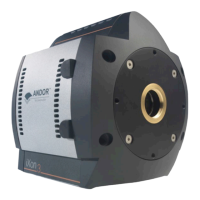Page 25
Features & Functionality
3.1.7 - EM Gain Ageing: What causes it and how is it countered?
As already noted in the discussion on safe camera operation in Section 2, EMCCD sensors can suffer from EM gain
ageing. This is the phenomenon whereby the EM gain falls off over a period of time when operating at the same clock
voltage and cooling temperature. This ageing effect appears to be dependent on the amount of charge that is passed
through the gain register, combined with the actual EM electric eld strength that it is transferred through. It seems to
be very strongly dependent on the EM electric eld strength. Therefore when operating at high EM gains the ageing rate
can be disproportionately greater. Fortunately, it has been observed that this ageing effect itself decreases with time,
meaning that with proper use the device should remain useful for many years. As part of Andor’s EMCCD production
processallsensorsareexposedtoconditionsthatresultsinmuchofthe“shorter-termageing”havingalreadyoccurred
prior to calibration and setting of the EM gain.
The explanation for this ageing effect is not fully understood, but it is assumed that accelerating charge through the
high electric elds is causing a tiny fraction of that charge to become permanently embedded in the insulator (typically
silicon dioxide) between the EM electrode and the active silicon. This slow build-up of charge effectively reduces the
eld strength produced by the electrode. The signal electrons therefore experience a lower accelerating potential
which subsequently produces fewer secondary electrons from the impact ionisation process resulting in less electron
multiplication and, in effect, a lower EM gain.
In order to minimise the effect of EM gain ageing it is recommended that the following guidelines are always adhered to:
• DonotuseEMgainsgreaterthannecessarytoovercomethereadnoise(pleaserefertogure 13 on page 25
and gure 14 on page 26). A rule of thumb is that a gain of x4 or 5 the root-mean-square read noise (accessible
from the performance sheet) is more than sufcient to render this noise source negligible. In practice, this can
always be achieved with EM Gain of less than x300 (often much less). Pushing gain beyond this value would
givelittleornoextraS/Nbenetandwouldonlyreducedynamicrange.
• OnlyselecttheextendedEMgainscaleofx1000whensingle photon counting and always ensure that the
signal falling onto the sensor is indeed within the regime of low numbers of photons per pixel.
• TurntheEMgainOFFwhennotinuse.
• Trynottoover-saturatetheEMCCDdetector.
For simplicity and ease of use many of these guidelines have been uniquely woven into the iXon3 systems, to make
it difcult for the user to step outside of them and unwaringly cause accelerated sensor ageing. This defence is two
pronged, and makes heavy use of Andor’s linear and quantitative gain calibration scale (RealGain
TM
) described above.
3.1.8 - Gain & signal restrictions
Part of the measures taken have been to invoke temperature compensated real gain limits, coupled with signal intensity
feedback(afterEMamplication).Thisensuresthattheuserisunabletoapplyexcessivegainand/orsignal,anymore
thanisnecessarytorenderthereadnoiseoornegligibleforagivensignalintensityandreadoutspeed.Secondly,when
notactuallyacquiringdata,forexample,during“keepclean”cyclesorwhenoutsideaselectedsub-imagearea,Andor
EMCCDs have been internally congured to prevent any unwanted signal entering the EM gain register. Together these
measures ensure that the rate of EM gain ageing is signicantly reduced.

